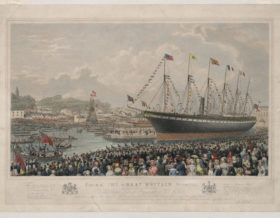Transporting revolution
In the early 1700s, transport was slow and unreliable with most people and goods travelling around the country on foot, horseback or river. The Age of revolution saw major advancements in travel and transport, with people and goods travelling further, faster and more cheaply than ever before. This was largely motivated by the need to move fuels and manufactured goods, such as coal and textiles, to their point of sale in other parts of the country and the world.
The period saw the construction of a network of canals stretching over 4,500 miles. Roads were steadily improved through turnpiking, a system administered by trusts who charged for traffic on the new thoroughfares connecting towns and cities and then used the proceeds for road maintenance and development, and through macadamisation – a precursor to tarmacking. Steam-powered shipping was also introduced culminating in Isambard Kingdom Brunel’s celebrated ocean liner SS Great Britain. Meanwhile, in France, the Montgolfier brothers engineered the first known flight to carry people with their famous air balloon and, in Germany, the first ‘bicycle’ was built. But perhaps the most significant innovation of all was the advent of the railways, with the first public, steam hauled public railway opening between Stockton and Darlington in 1825, leading to a network which stretched around the world and still survives today.















